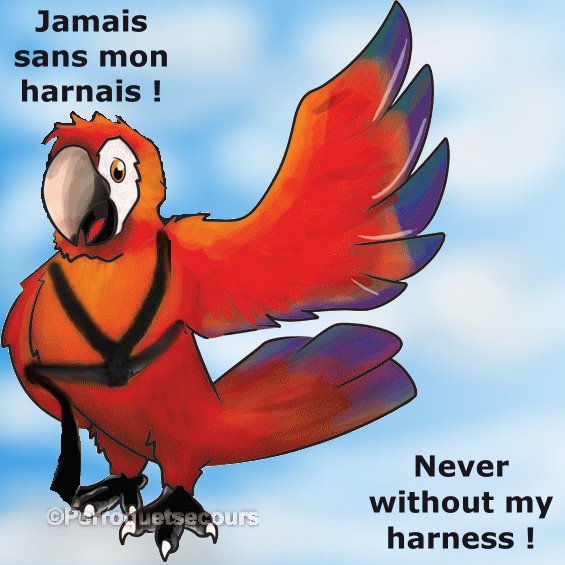
On voit de plus en plus d’adeptes du vol libre et pourtant même les plus chevronnés perdent leurs oiseaux. Un oiseau entraîné à revenir vers vous le fera probablement à l’extérieur, considérant qu’il en soit capable et qu’il ait ses ailes pleines. Un oiseau qui s’est envolé peut se voir contraint de ne plus pouvoir revenir si un prédateur le pourchasse, s’il heurte quelque chose ou s’il a été heurté par quelque chose, si le vent lui joue des tours, s’il s’est aventuré trop loin et a perdu son chemin, s’il est épuisé au point de tomber dans une grande étendue d’eau qu’il n’aura su traverser etc…
Quoi de plus beau qu’un oiseau qui vole librement? Effectivement, c’est de toute beauté mais si vous pratiquez le vol libre avec le vôtre, indéniablement un jour il ne reviendra pas…êtes-vous prêt à courir le risque?
On nous a également rapporté que plusieurs animaleries, vétérinaires et autres se spécialisant dans le domaine des oiseaux, prônent la taille d’ailes pour prévenir la perte d’un oiseau et cette croyance populaire est totalement erronée. Sachez que le 1/3 des oiseaux perdus ont ou avaient les ailes taillées. Pire encore, certaines personne se promènent avec leurs oiseaux sur l’épaule, les ailes pleines, croyant que leur oiseau restera là sans broncher ou restera sur une branche dans l’arbre où il a été déposé.
Quoi de plus enrichissant qu’une relation de confiance avec son oiseau au point de sortir avec lui dehors sans harnais, les ailes pleines ou taillées? Quand votre oiseau s’envolera suite à un bruit qui lui aura fait peur ou un mouvement brusque, ça n’aura rien à voir avec la confiance ou l’amour qu’il vous porte. C’est un réflexe de survie pour un oiseau de fuir au moindre danger, ailes pleines ou non. Si vous le perdez de vue alors qu’il a les ailes taillées, ses chances de survie sont diminuées considérablement.
Optez pour le harnais, c’est la façon la plus sécuritaire de permettre à son oiseau de voler à l’extérieur ou d’être avec vous à l’extérieur sur votre épaule. Vous aimez votre oiseau et la responsabilité d’assurer sa sécurité vous revient.
We see more and more adepts of free flight and yet even the most expert ones lose their birds too. A bird trained to return to you will probably do so outside , considering that he is able to and that he is fully flighted. A bird that flew off can no longer be able to return if a predator is on a hunt after him , if it hits something or was struck by something, if the wind plays tricks on him , if he ventured too far and lost his way back, if he is exhausted to the point of falling into a large body of water that he has not been able to cross etc …
What is more beautiful than a bird flying freely? Indeed, it is beautiful but if you practice free flight with your bird, undeniably one day he will not come back … are you willing to risk it ?
It was also reported that several pet stores, veterinarians and others specializing in birds, advocate wing’s feather trimming to prevent the loss of a bird and in reality, it is totally unsafe. So you know, one third of all lost birds have or had their wings trimmed. Worse still, some people walk around with their birds on their shoulder , fully flighted, believing that their bird will remain there no matter what or will remain on a branch in the tree quite where he was placed.
What’s more rewarding than a relationship based on trust, to the point of going outside with your bird without a harness, fully flightd or not? When your bird will fly off and he will, due to a noise that scared him or a sudden movement , it will have nothing to do with the trust or love he has for you. It is a basic survival instinct for a bird to take off at the slightest danger , full flighted or not. If you lose sight of your bird and he is not fully flighted, his chances of survival are reduced considerably.
Choose the harness which is the safest way to allow your bird to fly outside or to be with you outside on your shoulder. If you love your bird, keep him safe and secure, be responsible.